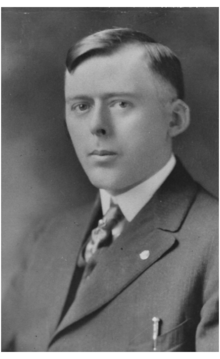- Charles Rood Keeran
-
Charles Rood Keeran (16 April 1883 - June 9, 1948) was an Illinois inventor and businessman.
Contents
Biography
He was born on 16 April 1883 on a farm near Bloomington, Illinois. Having an inventive father, William Lee Keeran, C.R. Keeran grew up with a creative spirit. After achieving a master's degree in engineering, he soon began patenting his ideas (circa 1906) which continued throughout his lifetime:
Keeran's 2-piece vacuum seal for Mason jars, which became the standard for home-canning, was immediately popular. However, he sold off his company, White Crown Fruit Jar, in order to finance his favorite invention: the Eversharp mechanical pencil. Around 1914, Keeran invented the basic mechanism for the Eversharp, thought up the "Eversharp" trademark (inspired by the Winchester Rifle logo), and set up a company to make and sell Eversharp pencils. He relocated to Evanston, Illinois, and entered into a business alliance with the Wahl Adding Machine Company in Chicago. Wahl officers obtained a majority share in the Eversharp Pencil Company and, in 1917, forced Keeran out of the company.
In 1919, Keeran registered the "Autopoint" trademark. In 1921, Keeran joined three businessmen in the Realite Pencil Company. Keeran brought the Autopoint name with him. Within a few years the company was renamed, the Autopoint Company.
Keeran felt that his invention and suggestions during his association with Wahl were the basis of their prosperity. For years, he fought a battle to get just compensation from the Wahl Company.[1] He got no satisfaction.
He died on June 9, 1948 in Chicago, Illinois.[2]
Patents
- U.S. Patent 877,435 New and useful Improvements in Detachable Spouts
- U.S. Patent 925,345 New and useful Improvements in Switch and Detector-Bar Throwing Mechanism
- U.S. Patent 1,111,905 Certain New and useful Improvements in Weapons
- U.S. Patent 973,512 Certain New and useful Improvements in Receptacle-Closures and #1130611, #1167306, #1180929, #1207560, and #1226532
- U.S. Patent 1,130,741 New and useful Improvements in Lead-Pencils and #1151016, and #1153115
Further reading
- Frary, C.A. "What We Have Learned Marketing Eversharp." Printers' Ink. 116(6):3+. August 11, 1921.
External links
- Charles Keeran, a Mechanical Pencil Pioneer
- A Tale of Two Pencils: Keeran's Eversharp & Hayakawa's Ever-Ready Sharp
References
- ^ Keeran v. The Wahl Co. (Illinois Appellate Court November 4, 1943) (“An action by plaintiff, the inventor of the Eversharp Pencil, against The Wahl Company, the manufacturer of said pencil, and others, for damages that plaintiff claims resulted from a conspiracy of defendants to injure and damnify him; to despoil him of his rights and interests in said pencil, his patents thereon and all patents relating thereto, and all his rights and interests in the Eversharp Company; "to render nil and vacuous his future business ventures"; "to render impotent his inventive gifts," and to ruin and destroy him through a series of alleged overt acts committed in pursuance of the conspiracy. Plaintiff demanded a jury trial.”).
- ^ "Charles Rood Keeran". Chicago Tribune. June 11, 1948. "The funeral of Charles Rood Keeran, 65, who was associated for many years with the mechanical pencil, will be held at 2:30 p.m. Saturday in the chapel at ..."
Categories:- 1883 births
- 1948 deaths
- American inventors
Wikimedia Foundation. 2010.

